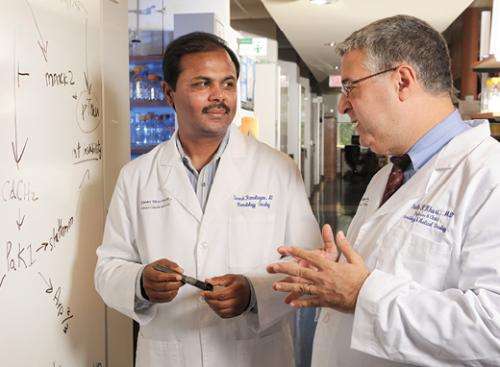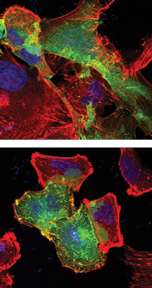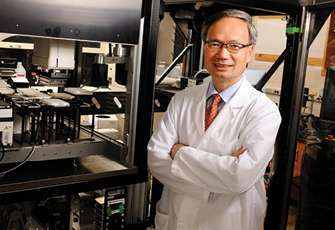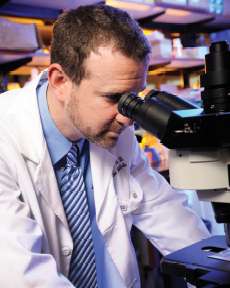When fighting lung cancer, every cancer is personal

Larry Dry's lung cancer was discovered by accident. The husky, physically active 69-year-old had no cough, no breathing problems, only a little tingling in one hand. When his doctor ordered an X-ray before surgery for a pinched nerve, he wasn't thinking lung cancer. Dry hadn't smoked in 40 years and a chest X-ray taken less than a year earlier had been perfectly clear. But the new X-ray contained ghostly images of large nodules. Non-small cell lung cancer. Stage IV, the most advanced kind. Eight months of gut-wrenching chemotherapy shrank the tumors, but they quickly rebounded. A second, less toxic drug didn't work.
Kathy Dry, a former CDC employee, asked the doctor if there wasn't something else for her husband, perhaps something at Emory. And that was how, in July 2013, Dry met Winship Cancer Institute oncologist Suresh Ramalingam, professor and director of Winship's Lung Cancer Program. Dry quickly entered one of the 20 to 30 ongoing lung cancer clinical trials underway at Winship, thanks to Winship's status as Georgia's only National Cancer Institute-designated cancer center. Dr. Ram, as his patients call him, is principal investigator of a multi-institutional Phase II trial testing the efficacy of a new class of immunotherapy cancer drugs, drugs that stimulate the immune system to attack cancer cells while sparing healthy ones.
Every two weeks, Dry met with Ramalingam and Colleen Lewis, nurse practitioner in Winship's busy clinical trials unit, and spent an hour in Winship's infusion center. A huge benefit of the new immunotherapy treatments, says Ramalingam, is how well they are tolerated. Dry's previous chemotherapy caused constant diarrhea. The new treatment only caused occasional gastrointestinal upset and he was able to regain lost pounds and his trademark energy. His tumors shrank by more than half and stayed that way for 11 months.
Thanks to their experience at Winship, Kathy Dry encourages people with lung cancer not to give up. There is hope, she says.
And more hope keeps coming, as Winship clinicians and scientists work with their research partners across campus and the country to design, develop, and test new, personalized treatment regimens. Increasingly those regimens are specific to each patient, such as strengthening an individual's own immune response, as with Dry, or identifying and honing in on the different genes involved in an individual's cancer or response to treatment.
Making it personal
Lung cancer is by far the leading cause of cancer death in men and women. But lung cancers – even specific types such as small-cell or non-small cell lung cancers – are not all the same. That's why, when lung cancer patients arrive at Winship, a small tissue sample of their tumor undergoes genomic screening to determine which gene has gone awry, driving that individual's cancer.
For example, among recently screened Winship patients with lung adenocarcinoma, a sub-type of non-small cell lung cancer, approximately 50-60 percent could be placed into a specific molecular genetic subcategory. "Knowing which gene is malfunctioning gives us a highly personalized target for treatment," says Ramalingam. "Our overarching theme in combating lung cancer at Winship is divide and conquer."
Targeting genes
The genetic testing panel studied for lung adenocarcinoma includes approximately 48 genes. Winship scientists are expanding that list with treatments to match. Take, for instance, the gene LKB1, mutated in 30 percent of all non-small cell lung cancers. This subgroup has a higher risk for metastasis, the process responsible for most cancer deaths. Adam Marcus, director of Winship's Integrated Cellular Imaging Core, uncovered how the LKB1 mutation promotes tumor spread. One possible answer is that once LKB1 mutates, it activates a flurry of production of a type of protein called focal adhesion kinase or FAK. Another gene, named KRAS, may initiate the original tumor, but when KRAS joins forces with mutant LKB1 and the hyperactive FAK proteins go to work, the tumor can spread.
In addition to shedding valuable light on how metastasis works in any type cancer, Marcus and Winship's multidisciplinary team – oncologists, pathologists, cell biologists, pharmacologists, molecular geneticists, biostatisticians, and others – are working to help this particular subgroup of patients. It's divide and conquer in action, here and now.

The first step was to add LKB1 to Winship's genomic screening panel. Second was to develop and test the first-ever treatment to inhibit the growth-promoting FAK proteins produced by the mutated LKB1 gene. In collaboration with pharmaceutical companies and other research institutions, Winship is planning a phase II clinical trial, involving Ramalingam, Winship Deputy Director Fadlo R. Khuri, and geneticist Wei Zhou. The new trial will show how well the treatment works in patients with mutant LKB1. Marcus believes targeting hyperactive FAK in LKB1-mutant patients will prevent new metastases, leading to more "progression-free survival."
Targeting vulnerability along the genetic pathway
Not all genes are as so obligingly evident. Others are considered "untargetable." For example, when a mutation causes what scientists call gain of function, therapies can be designed to inhibit this activity. Loss of function mutations – such as those that inactivate tumor suppressors – present additional challenges. But those are challenges the Winship team is finding new ways to meet.
Pharmacologist Haian Fu takes a network approach. Genes work through the proteins they create. And since protein-to-protein networks act as signal relay systems, the effect of a single mutated gene can alter the activity of genes along the network pathway, transmitting signals that drive tumor development and progression.
Several years ago, Fu began to focus on 14-3-3-zeta, a gene that controls cell division, growth and death in most living things. It can go into overdrive in lung cancer, however, markedly lowering survival. Understanding the gene's complex regulatory/signaling role has allowed the researchers to identify a series of cancer-associated proteins controlled by 14-3-3-zeta. Discoveries in the past few months alone include both tumor suppressors and tumor promoters, all players in lung cancer, all vulnerabilities that can be targeted and disrupted.
Creating the right bullet for each target
When it comes to developing novel therapeutic strategies for lung cancer, Fu and his lab have two important allies. One is long-time research collaborator Fadlo R. Khuri, chair of the Department of Hematology and Medical Oncology and Roberto C. Goizueta Distinguished Chair in Translational Cancer Research and a leading physician and clinical investigator in lung, head and neck and aerodigestive cancers. Fu says Khuri's commitment to his patients never lets the team forget the importance of what they are doing. Fu's second ally is the robot-assisted high-throughput screening technology in the Emory Chemical Biology Discovery Center, which Fu heads. High-throughput screening assays – immensely powerful tools that collect in minutes massive amounts of data that required months to collect only years ago – allow him to screen many thousands of compounds, looking for the half of one percent of compounds with the potential to reverse the cancer-promoting genetic changes along the pathway. A number of these compounds are now in development as potential new lung cancer therapies.
Creating a therapy sum greater than its parts
Other studies at Winship, often in partnership with the National Cancer Institute (NCI), its collaborative networks, and pharmaceutical companies, show what happens when traditional chemotherapy is enhanced with inhibitors of specific genes. An example: one goal of chemotherapy is to slow down rapidly multiplying cancer cells by damaging their DNA. Adding an agent that inhibits production of DNA repair proteins further weakens the cancer cells, making chemotherapy more effective.

If genomics is the current big thing in lung cancer advances, the next big thing, says Ramalingam, is likely to be using immunotherapy to treat cancer and studies to determine which traditional, genomic, immunotherapy or combined approaches work best for which genetic subgroup of patients. In fact, genomics is restoring the good name of some drugs that had not appeared very effective when results were tallied for all lung cancer patients as a group, but now prove extremely effective for specific genetic subgroups.
Ramalingam says "Winship is determined that each of our patients with lung cancer gets the best treatment to combat his or her unique disease. And we are equally determined to find new ways to do just that."
Smoke-Free Homes
Smoking inside is permitted by half of all homes with a smoker, even more in lower income households.
Living with smokers increases nonsmokers' chances of developing lung cancer by 20 to 30 percent.* But smoking inside is permitted by half of all homes with a smoker, even more in lower income households. A National Cancer Institute-funded study headed by Rollins School of Public Health's Michelle Kegler suggests most of those households are receptive to going smoke free and, with some simple help, can succeed.

In the summer of 2013, more than 4,000 callers to the United Way of Greater Atlanta's 211 call center were directed to the help they requested and were then asked a smoking-related question: did anyone regularly light up in the house? If yes, would they like to participate in a program to help them make their home smoke free? Eighty percent jumped at the chance. Three months later, 30.4 percent of those given materials and a coaching phone call from Emory Prevention Research Center staffers had earned their "smoke-free home" window sticker.
Like New Years' resolutions, behavioral changes often fade away. This one strengthened. After six months, the number of smoke-free homes had climbed to 40 percent.
As is standard in research determining intervention efficacy, half of participants received no materials or coaching, only 30-minute phone calls collecting data on secondhand smoke exposure in their houses. These phone calls alone were enough to nudge 14.9 percent of households to go smoke free at three months, rising to 25.4 percent by six months.
Emory's research partners at the University of North Carolina and University of Texas-Houston are now testing the intervention, using 211 agents instead of university staffers. If it works as well in their communities as in Atlanta, Washington University in St. Louis will expand the grant nationally in collaboration with Emory and other partners.
















